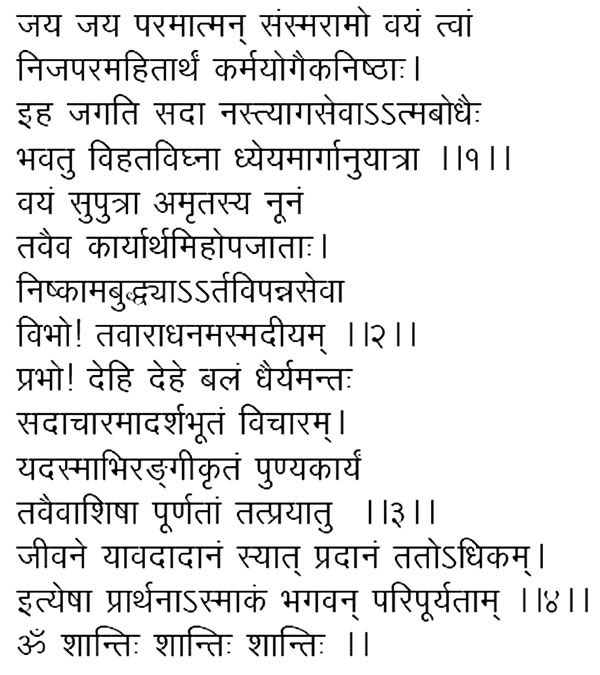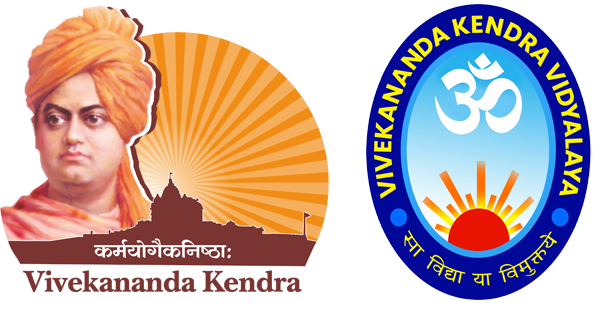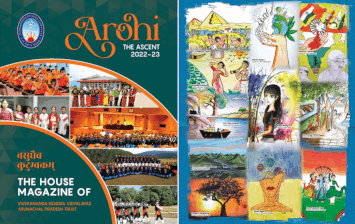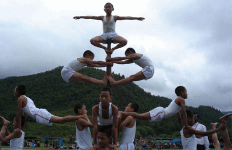Our Inspiration
Pranava Mantra (AUM)
"The goal which all the Vedas declare, which all austerities aim at, and which men desire when they lead the life of continence … is Om. This syllable Om is indeed Brahman. Whosoever knows this syllable obtains all that he desires. This is the best support; this is the highest support. Whosoever knows this support is adored in the world of Brahma."
~ Katha Upanishad I
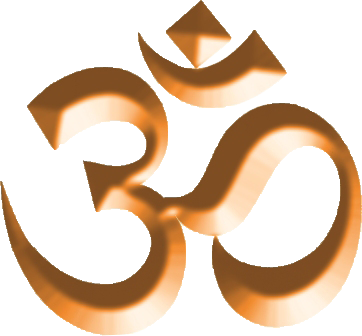
Om or Aum is of paramount importance in Hinduism. This symbol is a sacred syllable representing Brahman, the impersonal Absolute of Hinduism — omnipotent, omnipresent, and the source of all manifest existence. Brahman, in itself, is incomprehensible; so a symbol becomes mandatory to help us realize the Unknowable. Om, therefore, represents both the unmanifest (nirguna) and manifest (saguna) aspects of God. That is why it is called pranava, to mean that it pervades life and runs through our prana or breath.
Om in Daily Life
Although Om symbolizes the most profound concepts of Hindu belief, it is in use daily. The Hindus begin their day or any work or a journey by uttering Om. The sacred symbol is often found at the head of letters, at the beginning of examination papers and so on. Many Hindus, as an expression of spiritual perfection, wear the sign of Om as a pendant. This symbol is enshrined in every Hindu temple premise or in some form or another on family shrines.
It is interesting to note that a newly born child is ushered into the world with this holy sign. After birth, the child is ritually cleansed and the sacred syllable Om is written on its tongue with honey. Thus right at the time of birth the syllable Om is initiated into the life of a Hindu and ever remains with him as the symbol of piety. Om is also a popular symbol used in contemporary body art and tattoos.
The Eternal Syllable
According to the Mandukya Upanishad,"Om is the one eternal syllable of which all that exists is but the development. The past, the present, and the future are all included in this one sound, and all that exists beyond the three forms of time is also implied in it".
The Music of Om
Om is not a word but rather an intonation, which, like music, transcends the barriers of age, race, culture and even species. It is made up of three Sanskrit letters, aa, au and ma which, when combined together, make the sound Aum or Om. It is believed to be the basic sound of the world and to contain all other sounds. It is a mantra or prayer in itself. If repeated with the correct intonation, it can resonate throughout the body so that the sound penetrates to the centre of one's being, the atman or soul.
There is harmony, peace and bliss in this simple but deeply philosophical sound. By vibrating the sacred syllable Om, the supreme combination of letters, if one thinks of the Ultimate Personality of Godhead and quits his body, he will certainly reach the highest state of "stateless" eternity, states the Bhagavad Gita.
The Vision of Om
Om provides a dualistic viewpoint. On one hand, it projects the mind beyond the immediate to what is abstract and inexpressible. On the other hand, it makes the absolute more tangible and comprehensive. It encompasses all potentialities and possibilities; it is everything that was, is, or can yet be. It is omnipotent and likewise remains undefined.
The Power of Om
During meditation, when we chant Om, we create within ourselves a vibration that attunes sympathy with the cosmic vibration and we start thinking universally. The momentary silence between each chant becomes palpable. Mind moves between the opposites of sound and silence until, at last, it ceases the sound. In the silence, the single thought—Om—is quenched; there is no thought. This is the state of trance, where the mind and the intellect are transcended as the individual self merges with the Infinite Self in the pious moment of realization. It is a moment when the petty worldly affairs are lost in the desire for the universal. Such is the immeasurable power of Om.
Bharat Mata
Bharat Mata (Hindi, from Sanskrit भारतमाता), Mother India, or Bharatamba (from अंबा amba' mother' ) is the national personification of Indiaas a mother goddess. She is usually depicted as a woman clad in an orange or saffronsari holding aflag, and sometimes accompanied by alion.
The image of Bharat Mata formed with the Indian independence movement of the late 19th century. A play by Kiran Chandra Bandyopadhyay, Bharat Mata, was first performed in 1873. Bankim Chandra Chattopadhyay's 1882 novel Anandamath introduced the hymn "Vande Mataram" which soon became the song of the emerging freedom movement in India.
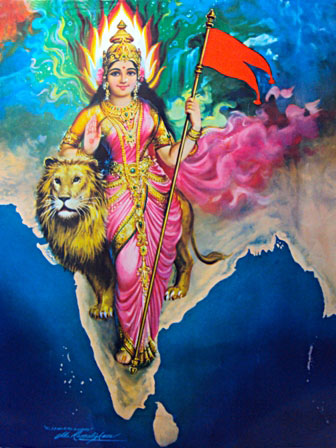
Abanindranath Tagoreportrayed Bharat Mata as a four-armed Hindu goddess wearing saffron colored robes, holding a book, sheaves of rice, amala, and a white cloth.
In 1936, a Bharat Mata temple was built in Benaras by Shiv Prashad Gupt and was in augurated by Mohandas Gandhi. Mahatma Gandhi said, "I hope this temple, which will serve as a cosmopolitan platform for people of all religions, castes, and creeds including Harijans, will go a great way in promoting religious unity, peace, and love in the country.
Swami Vivekananda
Hero Of Youth
"Let us proclaim to every soul..- Arise, awake and stop not till the goal is reached.Arise, Awake from hypnotism of this weakness.
None is really weak; the soul is infintes, omnipotent and omniscient. Stand up, assert yourself, proclain the GOD within you, do not deny him!
Too much of inactivity, too much of weakness, too much of hypnotism, has been & is upon our race. O ye morden Hindus, de-hypnotise yourselves.
The way to do that is found in your own sacred books. Teach yourself, teach everyone his real nature, call upon the sleeping sould and see how it awakes.Power will come, glory will come, goodness will come, purity will come, everything that is excellent will come when this sleeping soul is roused to self-consicous activity.
Ay, If there is anything in the Gita that I like , it is these verses, coming out strong as the very gist, the very essence, of Krishana's teaching "He who sees the supreme Lord dwelling alike in all beings, the Imperishable in the things that perish, he sees indeed. For seeing the Lord as the same, everywhere present, he does not destory the self by the self, and thus he goes to the highest goal."
Swami Vivekananda
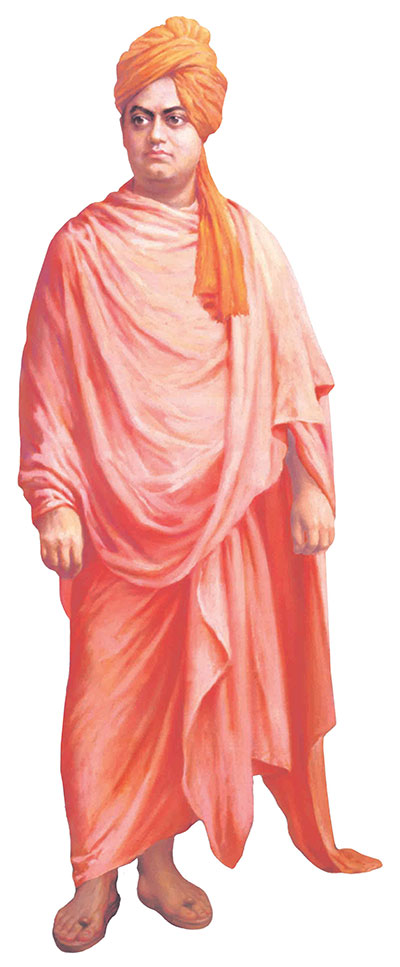
Spirit Behind Vivekananda Rock Memorial & Vivekananda Kendra
When the whole country was busy with enthusiastic preparations for the celebration of the Centenary Year of Swami Vivekananda, Shri Eknathji Ranade compiled as his own personal homage to the great patriot-saint the book "Rousing Call to Hindu Nation" which was published in January 1963.
Chronology of Eknathji's Life19.11.1914 – Born at Timtala, Amaravati District Maharastra.
- 1920 – Came to Nagpur: Had primary education in Pradanavispura School.
- 1926 - Joined RSS(Ratriya Swayam Sevak Sangh) as a Swayamsevak
- 1932 – Passed Matriculation examination from New English High School, Nagpur.
- 1938 – Passed B.A. (Hons.) in Philosophy (equal to M.A.)
- 1938 – Become a Pracharak of RSS at Jabalpur.
- 1946 – Passed L.L.B. From LAW collage, Jabalpur. Prant Pracharak of Mahakoshal and Madhya Bharat.
- 1948 – Went underground during the ban on RSS. Also worked from lifting of the ban. Held negotations with Saradar Vallabhbhai Patel and others.
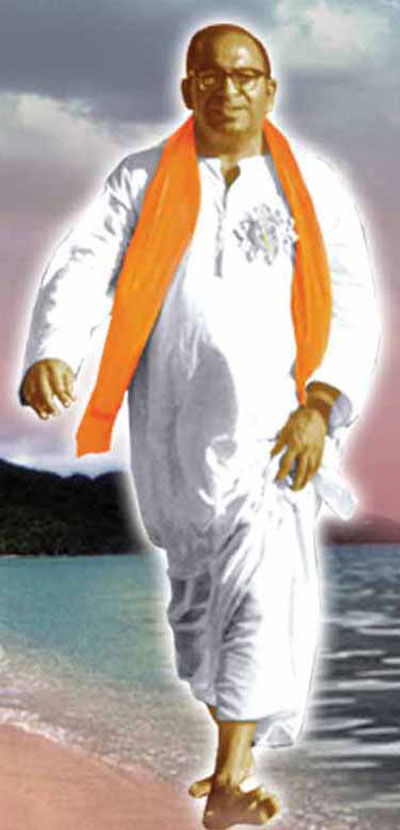
- 1949 – Was in Jail for about a month.
- 1950 – Kshetra Pracharak for Poorvanchal Kshetra comprising Bengal, Orissa, and Assam. Did outstanding work for the refugees coming from Pakistan by establishing a very effective “Vastuhara Sahayata Samiti”.
- 1953 – Akhil Bharatiya Prachar Pramukh.
- 1955 – Sarkaryavah (General Secretary) of RSS.
- 1962 – All india Baudhik Pramukh of RSS.
- 17.01.1963 – Compiled “Rousing call to Hindu Nation” , containing the thoughts of Swami Vivekananda, on the eve of his birth centeary.
- 18.08.1963 – Organising Secretary of Vivekananda Rock Memorial Committee.
- 1972 – Founded “Vivekananda Kendra”- a Spiritually Oriented Service Mission.
- 1973 – Founded Editor of “Yuva Bharati”, “Kendra Bharati”, “Vivekananda Kendra Patrika”. Editor of revived “Brahmavadin”.
- 28.05.1975 – General Secretory of Vivekananda Kendra.
- 1978 – President of Vivekananda Kendra.
- 1982 – President of Vivekananda Kendra International.
- 22.08.1982 – Nirvana at Madras.
- 23.08.1982 – Cremated at Vivekanandapuram, Kanyakumari.
"Freed from attachment, non-egoistic, endowed with courage and enthusiasm and unperturbed by success or failure, the worker is known as a pure(Sattvika) one. Four outstanding and essential qualities of a social worker are enunciated in the verse."
Spirit behind Vivekananda Rock Memorial & Vivekananda Kendra When the whole country was busy with enthusiastic preparations for the celebration of the Centenary Year of Swami Vivekananda, Shri Eknathji Ranade compiled as his own personal homage to the great patriot-saint the book "Rousing Call to Hindu Nation" which was published in January 1963. Chronology of Eknathji's Life19.11.1914 – Born at Timtala, Amaravati District Maharastra. 1920 – Came to Nagpur: Had primary education in Pradanavispura School. 1926 - Joined RSS(Ratriya Swayam Sevak Sangh) as a Swayamsevak 1932 – Passed Matriculation examination from New English High School, Nagpur. 1938 – Passed B.A. (Hons.) in Philosophy (equal to M.A.) 1938 – Become a Pracharak of RSS at Jabalpur. 1946 – Passed L.L.B. From LAW collage, Jabalpur. Prant Pracharak of Mahakoshal and Madhya Bharat. 1948 – Went underground during the ban on RSS. Also worked from lifting of the ban. Held negotations with Saradar Vallabhbhai Patel and others. 1949 – Was in Jail for about a month. 1950 – Kshetra Pracharak for Poorvanchal Kshetra comprising Bengal, Orissa, and Assam. Did outstanding work for the refugees coming from Pakistan by establishing a very effective “Vastuhara Sahayata Samiti”. 1953 – Akhil Bharatiya Prachar Pramukh. 1955 – Sarkaryavah (General Secretary) of RSS. 1962 – All india Baudhik Pramukh of RSS. 17.01.1963 – Compiled “Rousing call to Hindu Nation” , containing the thoughts of Swami Vivekananda, on the eve of his birth centeary. 18.08.1963 – Organising Secretary of Vivekananda Rock Memorial Committee. 1972 – Founded “Vivekananda Kendra”- a Spiritually Oriented Service Mission. 1973 – Founded Editor of “Yuva Bharati”, “Kendra Bharati”, “Vivekananda Kendra Patrika”. Editor of revived “Brahmavadin”. 28.05.1975 – General Secretory of Vivekananda Kendra. 1978 – President of Vivekananda Kendra. 1982 – President of Vivekananda Kendra International. 22.08.1982 – Nirvana at Madras. 23.08.1982 – Cremated at Vivekanandapuram, Kanyakumari.
Kendra Prarthana
